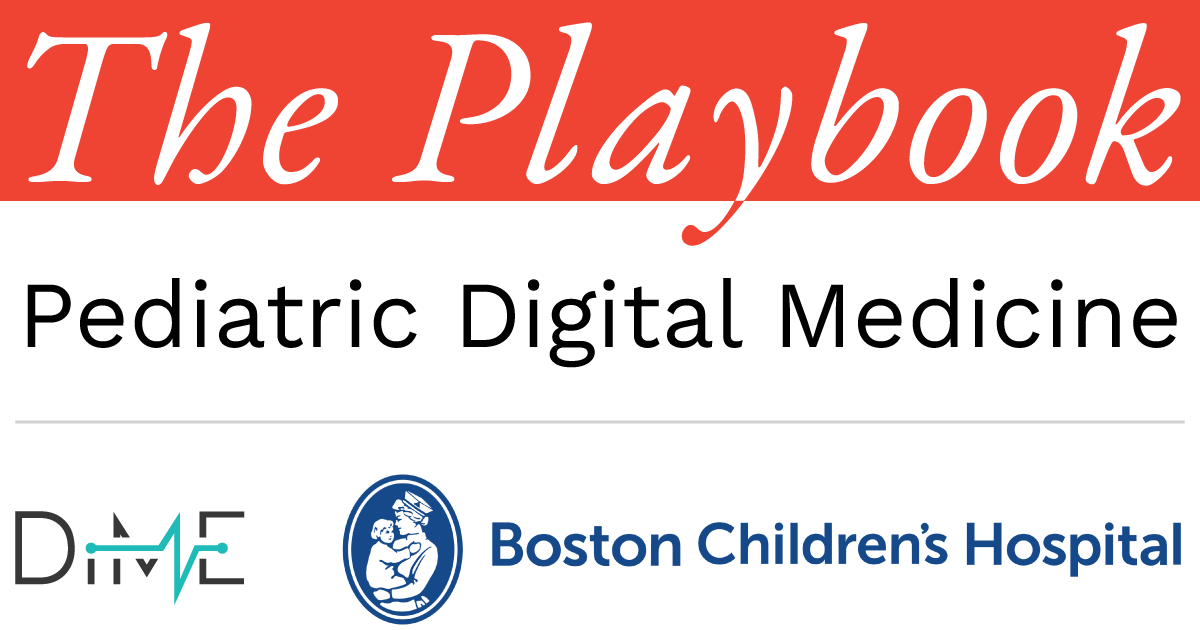
Chapter 1 – Section 3
Navigate the road to growth and impact

This section addresses barriers such as fragmented care systems, regulatory complexity, and the “budget dust” perception, providing strategies for you to overcome these challenges and create a seamless ecosystem for pediatric DHT adoption.
What’s inhibiting investment into pediatrics?
The pediatric market is highly complex, with varying needs based on age, condition, and socioeconomic factors. Despite the market’s growth potential, several considerations should be taken into account:

Financial and investment barriers
- “Budget dust” mentality: The underestimation of pediatrics as a small market segment.
- Return on Investment (ROI) and “wrong pockets”: Hesitation due to long-term returns and misaligned incentives.
- Reimbursement and financial models: Difficulty fitting pediatric DHTs into traditional frameworks.
- Investor and payor perspectives: Challenges in demonstrating value under varying lenses.

Market dynamics and challenges
- Data privacy and security: Compliance with stringent laws and secure platform demands.
- Shifting consumer behavior and expectations: Demand for personalized and on-demand solutions.
- Integration across care settings: The challenge of connecting various environments (schools, homes, hospitals).
- Digital health equity: Addressing disparities in access based on socioeconomic and geographic lines.
- Regulatory complexity: Navigating strict standards for data privacy and safety.
Return on Investment (ROI):
The benefits gained from an investment in healthcare services, treatments, or technologies relative to the costs incurred. ROI measures the efficiency and value of these investments, often considering both economic returns (e.g., cost savings, revenue generation) and health outcomes (e.g., improved patient care, reduced hospitalizations).
Wrong pockets:
A situation where one organization or sector invests in solving a problem, but the resulting benefits or returns are realized by another organization or sector. This can create a disincentive for the investing party, as they bear the costs without directly receiving the rewards.
Payor:
The person, organization, or entity that sets service rates, collects payment, processes claims, and pays claims associated with healthcare services administered by a provider. Most often refers to private insurance companies that provide their customers with health plans that offer cost coverage, and reimbursements for medical treatment and care services
Health Equity:
Health equity means that everyone has a fair and just opportunity to be as healthy as possible. This requires removing obstacles to health such as poverty, discrimination, and their consequences, including powerlessness and lack of access to good jobs with fair pay, quality education and housing, safe environments, and health care.
Beyond budget dust: Making pediatrics a priority market
Pediatrics is often perceived as a small, less profitable segment of healthcare, limiting investment. Challenges include:
- Low perceived market value: Pediatric care is seen as less lucrative compared to adult health.
- Fragmented demand: The diversity of conditions and age groups within pediatrics complicates market dynamics.

What this means for you:
- Highlight the lifetime ROI and frame pediatric health investments as foundational, emphasizing how early interventions reduce lifetime healthcare costs.
- Leverage market segmentation: Focus on scalable subsegments of pediatric health (e.g., chronic conditions like asthma or behavioral health tools) to demonstrate impact and build momentum for broader adoption.
- Educate stakeholders: Develop targeted communications for payors and policymakers to illustrate how digital health tools designed for children can improve outcomes and reduce costs across systems.
Investing for impact: Aligning ROI with long-term health
When one sector benefits from the investment of another, it is referred to as “wrong pockets.” For example, in the U.S., private insurance companies often face challenges due to patient mobility—on average, patients change health plans every few years. This creates a short-term focus on immediate ROI rather than on investments in care that could lead to long-term cost savings, which the original payor may not realize.

What this means for you:
- Adopt value-based approaches, which are gaining traction in the U.S. and worldwide.
- Collaborate across systems to form partnerships between public and private sectors can help distribute costs and benefits more equitably.
- Consider pathways to sustainability in the U.S. Medicaid is leading the way in value-based payment and is an increasingly viable pathway for pediatric digital health sustainability. Read more in our Medicaid guide.
Breaking the mold: Redefining reimbursement models for child health
One of the most significant barriers to adoption of pediatric DHTs is the lack of clear reimbursement pathways. Unlike adult healthcare, where telemedicine and digital tools are increasingly covered by insurance, pediatric digital health often struggles to fit into traditional reimbursement frameworks. Barriers include:
- Limited insurance reimbursement in both public (Medicaid) and private insurance programs.
- Inconsistent reimbursement policies that can vary significantly from state to state or between different insurance providers.

What this means for you:
- Prove that digital tools lead to key metrics, like reduced emergency visits, fewer hospitalizations, and better long-term outcomes that can drive changes in reimbursement policies. Learn more about this concept in the context of Medicaid in our guide.
- Collaborate with industry and patient organizations to call for expanded reimbursement coverage of pediatric DHTs.
- Engage payors via the FDA’s Payor Communication Task Force.
Seeing the bigger picture: Unlocking value for payors and investors
One of the biggest challenges in advancing pediatric DHTs is the perception of limited short-term ROI. Investments in pediatric tools may benefit different stakeholders than those who bear the initial costs, leading to the “wrong pockets” problem. Pediatric care often requires a long-term lens, with outcomes like improved childhood health translating into reduced adult healthcare costs. Payors and investors need compelling evidence of how DHTs drive both clinical and economic outcomes over time.

What this means for you:
- Generate compelling evidence for value-based care models. Demonstrate how your DHTs can reduce costs and improve outcomes in the short term, such as fewer hospital visits, better disease management, or reduced caregiver burden. This framing can help align with the priorities of payors and investors.
- Highlight the multi-stakeholder benefits of your pediatric DHTs: Show how tools provide value across sectors, including employers, schools, and public health systems. For example, a school-based DHT may reduce absenteeism, which is valuable to both families and employers.
Safeguarding trust: Balancing privacy and access
Data privacy and security are paramount in pediatric digital health and present significant challenges. Developers must navigate complex regulations, such as the Health Insurance Portability and Accountability Act (HIPAA), while ensuring platforms remain accessible and user-friendly for families. Barriers include:
- Stringent compliance requirements: Pediatric data protection laws are highly restrictive, making it difficult to innovate.
- Trust concerns: Families may hesitate to adopt digital tools due to fears of data breaches or misuse.
- Balancing privacy with interoperability: Ensuring secure data-sharing between systems without compromising privacy is a key challenge.

What this means for you:
- Implement robust and transparent security measures to build trust with families and providers.
- Proactively communicate how data is used, stored, and shared.
- Use advanced encryption and compliance tools to simplify adherence to privacy regulations while maintaining usability.
- Advocate for clear, consistent data protection policies that balance innovation with security.
- Develop educational resources to help families understand how you protect their children’s data.
Meeting families where they are: Adapting to personalized expectations
Patients and caregivers today are more tech-savvy than ever, with high expectations for convenience, transparency, personalization, and real-time data. This shift in behavior is driving demand for pediatric digital health solutions that empower families to take a proactive role in their child’s care. However, challenges remain:
- Digital literacy: More families use health technology today than a decade ago, but disparities still remain. Limited internet access, technology availability, and digital literacy challenges often align with socioeconomic and demographic factors.
- Adapting to the care environment: Families also want solutions that can grow with their child’s capabilities and care systems.

What this means for you:
- Ensure that your products are easy to use and accessible for families, considering socioeconomic factors, language barriers, and other personal dynamics.
- Account for life changes and transitions, offering flexibility and adaptability for caregiver involvement as children age.
- Learn more about creating user-centric DHTs that account for these important topics in chapter 2.
Health for all: Bridging the digital divide in pediatric care
Access to DHTs remains uneven, with marginalized communities often left behind. This digital divide exacerbates health disparities among children. Barriers include:
- Socioeconomic challenges: Families in underserved areas may lack access to devices or reliable internet.
- Geographic disparities: Rural communities often face additional hurdles in adopting digital tools.
- Language and literacy barriers: Many tools fail to account for diverse languages and varying levels of literacy (digital and reading).

Product developers – what this means for you:
- Create low-cost, offline-capable tools to expand access to underserved populations.
- Design multilingual and culturally sensitive interfaces to reach a broader audience.
- Build accessible, user-centered tools.
Policymakers and advocacy groups – what this means for you:
- Advocate for programs that subsidize devices and internet access for low-income families.
- Partner with community organizations to improve digital literacy and adoption.
Connecting the dots: Integrating care across settings
Pediatric care spans a wide array of settings, including homes, schools, community centers, and hospitals. Digital tools often struggle to integrate seamlessly across these environments. Key barriers include:
- Fragmented care ecosystems: Communication breakdowns between providers, caregivers, and educators hinder coordination.
- Lack of interoperability: Many digital health tools are not designed to share data across settings.
- Overburdened stakeholders: Caregivers and school staff may lack the time or training to use digital tools effectively. They may be hesitant to adopt digital health tools due to concerns over the reliability of data, time constraints, and unfamiliarity with the technology.

What this means for you:
- Design tools that prioritize interoperability, enabling smooth data-sharing across systems and settings.
- Include user training and support to empower caregivers and educators to use your tools confidently.
- Facilitate collaboration between schools, healthcare systems, and community organizations to ensure tools address the full spectrum of care settings.
Interoperability:
The ability of different information systems, devices and applications to access, exchange, integrate and use data in a coordinated manner, within and across organizational, regional and national boundaries, to provide timely and seamless portability of information and optimize the health of individuals and populations globally.

Meet Amir
Amir’s experience highlights the challenge of connecting care across different settings. While his smart inhaler provides real-time data for his pediatrician, the lack of seamless communication between school staff and his healthcare team sometimes creates gaps in his care. With better-integrated tools, caregivers and educators could more easily share information, ensuring Amir’s asthma is managed effectively both at school and at home.
Personas illustrate key points in action, showcasing real-world applications and practical scenarios based on fictional personas.
Navigating regulatory hurdles to innovate
Strict regulatory requirements in pediatric healthcare ensure safety but can also stifle innovation. Developers face:
- Prolonged approval processes: Regulatory pathways are often lengthy and unclear for digital health tools.
- High compliance costs: Meeting stringent standards can strain resources, especially for startups.
- Uncertainty around evolving regulations: The rapid pace of technology outpaces regulatory updates, creating ambiguity.

What this means for you:
- Collaborate with regulatory stakeholders, like the FDA’s Q-submission program, early in the design process to align on expectations and streamline approvals.
- Get informal feedback into your regulatory questions from FDA by emailing DigitalHealth@fda.hhs.gov.
- Invest in compliance expertise to navigate complex requirements efficiently. Solutions that navigate regulatory hurdles effectively will have a faster time to market and lower risk.
- Applications for pediatric-specific devices have user fees exempted and fees waived by FDA.
- Read DiMe’s U.S. focused regulatory pathway report for an in depth view to the regulatory process.

Key insights
Key regulatory resources for pediatric DHTs
A curated list of helpful resources and programs for pediatric device innovators.
Digital Health Center of Excellence | FDA
The Digital Health Center of Excellence empowers digital health stakeholders to advance health care by fostering responsible and high-quality digital health innovation.
Pediatric Medical Devices | FDA
On this page, you will find various information and resources about pediatric medical devices and pediatric device initiatives at the FDA.
Digital Health Policy Navigator | FDA
The Digital Health Policy Navigator is a tool intended to help product developers understand whether a software function is potentially subject to or the focus of the FDA’s regulatory oversight as a device, and if so, the considerations that may assist in determining the applicable FDA-specific legal and regulatory requirements and recommendations.
Digital Health and Artificial Intelligence Glossary – Educational Resource| FDA
Commonly used terms in the digital health, artificial intelligence, and machine learning space and their definitions.
Pediatric Medical Product Safety | FDA
The FDA maintains robust programs and systems for monitoring postmarket safety.
Policy for Device Software Functions and Mobile Medical Applications Guidance for Industry and Food and Drug Administration Staff | FDA
Read this to learn how the FDA plans to regulate software on mobile apps and general-purpose computers. The agency explains which software functions it will oversee and provides guidelines for companies that develop or distribute these programs.

Catalyzing change: Actionable insights from The Playbook team
Advocate for clear, consistent policies and standards:
- Promote interoperability standards to enable seamless data sharing across care settings.
- Push for regulatory fast-tracks for pediatric digital health solutions to speed up innovation.
Build evidence to drive adoption and reimbursement:
- Collect robust real-world evidence (RWE) linking digital tools to improved outcomes and cost savings.
- Develop ROI frameworks that highlight multi-stakeholder benefits and align with value-based care models.
Prioritize accessibility and equity:
- Design tools with affordability and offline capabilities in mind for underserved populations.
- Partner with schools and community organizations to improve digital literacy and expand access.
Align stakeholders for long-term investment:
- Demonstrate the societal value of pediatric digital health tools to attract investors, payors, and policymakers.
- Address the “wrong pockets” problem by fostering collaborations between sectors (e.g., healthcare and education).
Innovate for personalization and family engagement:
- Develop adaptive technologies and user-friendly interfaces tailored to diverse pediatric needs.
- Actively involve families and clinicians in the co-design of solutions to ensure relevance and usability.
Support clinicians and educators as champions:
- Provide targeted training for stakeholders to maximize the impact of digital tools.
- Create incentives and resources to ease adoption in clinical and educational settings.
Drive industry collaboration to amplify impact:
- Form coalitions among product developers, advocacy groups, and healthcare organizations to tackle systemic barriers.
- Share success stories to shift the narrative and normalize investment in pediatric health innovation.
Case studies









